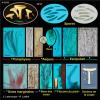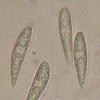
16-03-2014 22:00
Hello,I found this species a few months ago but ha

08-12-2025 13:39
Thomas Læssøehttps://svampe.databasen.org/observations/10572899

07-12-2025 16:07
Arnold BüschlenHallo, ich habe in einer Moos-Aufsammlung (epiohy

05-12-2025 17:33
 Bruno Coué
Bruno Coué
Bonjour, je serais heureux de recueillir votre avi

07-12-2025 09:24
De la pasada semana en Galicia EspañaEn el suelo

06-12-2025 00:19
 Viktorie Halasu
Viktorie Halasu
Hello, would anyone have this article, please? An
50528 - Hymenoscyphus scutula ?
Roland Labbé,
24-03-2010 04:14
Voici un autre Hymenoscyphus récolté à Québec.
C'est peut être H. scutula, mais les spores et les soies ne semblent pas conforme.
Merci pour l'aide !
Roland
Détails :
Date de récolte : 18 / 10 / 2009
Habitat : tas de détritus à découvert
Substrat : tige d'herbacée
Spores cylindriques-fusoïdes, lisses, longuement apiculées aux deux extrémités, avec 5 guttules, verdâtre pâle en NaCl iso, réfringentes, 24-31 x 4-5um, 27,1 x 4,6 µm en moyenne (20 spores), Q = 5,89
Asques à 8 spores en majorité bisériées, avec pore apical amyloïde et sans crochet, 110-130- x 8-10 µm en moyenne (10 asques)
Paraphyses cylindriques, légèrement élargies à l'apex, non ramifiées, septées, à contenu huileux (?) finement granuleux à 90-100%, finement incrustées, surtout à l'apex, dépassant légèrement les asques de 2-3 µm
Soies marginales très abondantes, en palissade serrée, semblables aux paraphyses, 35-50 x 2-3 µm
Excipulum ental formé de cellules étroitement cylindriques, septées, 3-5 µm de diam.
Excipulum ectal en textura porrecta ascendant, formé de cellules largement cylindriques à subglobu- leuses, à angles obtus, septées, 15-30 x 11-16 µm
Flocons en surface du pied formés de cellules variées, cylindriques, lagéniformes, clavées à globuleuses, septées, avec excroissance à la base, pigmentées et incrustées d'ocre brunâtre en Nacl iso., en amas
Hans-Otto Baral,
24-03-2010 13:00

Re:50528 - Hymenoscyphus scutula ?
Hi Roland
I see no difference to typical H. scutula here. What do you think is different? Spore size and shape, and length of setulae seems typial to me.
You apparently did this microscopy from the dried material because even the spores are dead. Oil drops in living spores often help to be more sure.
Here I add an image showing living spores. Spore size was distinctly shorter, yes: *19-22.5 x 4.8-5.5 µm. There are sometimes such long-spored collections, which are not sharply delimited from the short-spored ones. I think this is mere variation.
Zotto
I see no difference to typical H. scutula here. What do you think is different? Spore size and shape, and length of setulae seems typial to me.
You apparently did this microscopy from the dried material because even the spores are dead. Oil drops in living spores often help to be more sure.
Here I add an image showing living spores. Spore size was distinctly shorter, yes: *19-22.5 x 4.8-5.5 µm. There are sometimes such long-spored collections, which are not sharply delimited from the short-spored ones. I think this is mere variation.
Zotto
Roland Labbé,
24-03-2010 16:56
Re:50528 - Hymenoscyphus scutula ?
Thanks you Hans !
Acording to you, what serve the longs apiculus of these spores ?
Are they the same role than the flagella of certains organisms ?
Roland
Acording to you, what serve the longs apiculus of these spores ?
Are they the same role than the flagella of certains organisms ?
Roland
Hans-Otto Baral,
24-03-2010 17:09

Re:50528 - Hymenoscyphus scutula ?
They are non-motile, but they might play a role either in influencing the flight of the spore, or more probably to get entangled somewhere. Have no clear idea.
Zotto
Zotto


